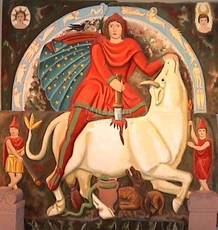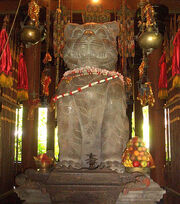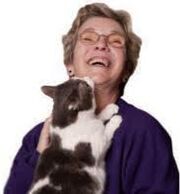| Felinism نكهيه Nkaía Cultus Felium | |
|---|---|
 | |
| Type | Selucian Pagan |
| Theistic philosophy | Pantheistic, Polytheistic |
| Holy City | various |
| Region | Selucia, Pontesi, Barmenistan, diaspora |
| Founder | Ershébef Kepahisn |
| Founded | 32nd century |
| Merged into | Religio Seluciana |
| Liturgical language | Classical Brmek, Selucian |
| Members | c. 40 million |
Felinism (Old High Jelbic: Nkaía, Classical Brmek: نكهيه Nekaiya, Selucian: Cultus Felium) is an animalistic religion centred around the idea of feline species as being divine beings. Although a modern religion founded in the 30th century, Felinism has its roots in the pre-Ahmadi indigenous shamanistic pagan religion practiced by the early Jelbic tribes of Barmenistan, with significant influences from Qedarite (Semitic) mythology and Selucian Paganism. Many archaeological findings tell of the reverence of cats from ancient times, especially in the ancient Qedarite ziggurats found in Barmenistan. Many Felinists belong to the Selucian minority in Barmenistan. In the 39th century Felinism was driven underground as a result of the resurgence of Ahmadism and a ban on the religion, culminating in the expulsion of crypto-Felinists as part of the Barmenian Refugee Crisis, a plurality of whom relocated to Selucia where they were accepted as practitioners of Selucian Paganism and cat worship was integrated into the Religio. After a few centuries of underground practice Felinism gradually returned to prominence in Barmenistan, where it is currently the second largest religion.
Overview[]
Felinism was long a religion of peasants and mountainous villagers in the predominantly Ahmadi Barmenistan, but rose into prominence once again after the collapse of the monarchy of the Selucianist House of Victoria and the subsequent Sultanate of Barmenistan. Led by the charismatic Lady Ershébef Kepahisn, the Cult of the Sacred Feline established itself as the state religion of Barmenistan, with her daughter, Jesík Kepahisn taking on the worldly leadership over the state. However, little religious persecution did exist during the time, and many chose to combine their Felinist beliefs with other religions. The resurgence of Felinism has been explained by historians as a combination of the decline of Ahmadism during the previous regime, combined with a vacuum of social instability that allowed a charismatic leader and a movement with a clear vision to rose to power.
Theology[]

Modern cat Ziggurat in Varishehr, Murdhild
At the centre of Felinist worship lies the idea of "Discerning the General Feline Will". The term describes the process or state of mind which enables one to humbly wait upon the Feline Divinity for guidance. Discernment may be conducted in a multitude of ways as there are no rigid rules. However it was accustomed that believers wore cat ear like head ornaments and other cat like accessories, a believer can do it whilst riding a bike in the park or watching television with a cat sat on their lap. One may find yourself entering the state of discernment whilst in discussion with friends or colleagues. Felinists often rely on a Guide, meaning a cat who has come forward to help that person make their life choices.
Orthodox Felinists, like Lady Ershébef and the priesthood of the Sacred Cult, literally believe that cats comprise the Godhead or Feline Divinity and that serving cats is the moral purpose humans are created for. Less orthodox Felinists, whilst according cats the highest place of honour, may take a more pantheistic view, seeing the worship of cats as a powerful metaphor for developing a closer relationship with the spirituality present within ourselves and in nature. As previously stated, others take a syncretistic approach, venerating cats whilst also drawing on concepts from other religions. It used to be common for Felinists to also regard themselves as, say, Hosians, Israi, Abadi, Yeudi or Daenists and still feel comfortable with their beliefs and be fully accepted within the Felinist community, but following the ban on Felinism in Barmenistan and the faith's integration within Selucian Paganism, cat worship was largely purified of external elements. There is still much variety within Felinist practice, and a number of Felinist sects were granted official recognition by the Selucian Religio.
Felinists regard their faith as a natural religion which has always existed in some form or degree, and so are reluctant to credit any single individual as being their founder. However, Lady Ershébef is inarguably the spark that began the modern Felinist movement. Although personally a very modest woman who shied from public attention, she acquired the status of a towering figurehead not only for the Sacred Cult and Felinism but for Barmenistan itself.
Gods and denominations[]
Sacred Feline Cult[]
The Sacred Feline Cult, also known as Orthodox Felinism, is the oldest Felinist sect. During the resurgence of the faith under Lady Ershébef, all cats were considered parts of the Feline Divinity, but the one worthy of special reverence was Bastet, who was said to be the Goddess of Fertility worshipped in ancient times. The Felis Supremis or Hldjeznka was believed to be the latest incarnation of Bastet, and under the Feline Homeland the Felis Supremis was the official Head of State of Barmenistan. Whenever a Felis Supremis died, believers subsided into ten days of official mourning, during which followers ceased all significant business activity, fasted, prayed, donated their riches to Cat Temples and wailed loudly through the streets whilst crawling on all fours with their eyes facing downwards, fearing that unless Bastet returned the plants would all die and all living life perish. On the eleventh day a search began, supervised by the Sacred Cult, to find the next Felis Supremis from amongst the kittens in Barmenistan's most prominent Cat Temples. The selected kitten was usually a queen (female), although there were occasions when Bastet chose to return as a tom (male). After the new Felis Supremis was anointed, there followed a spontaneous outburst of religious fervour and wild celebrations.
In 3179 a radical doctrinal change occurred within Orthodox Felinism when Galt Freyja, a charismatic and mysterious individual, was recognized as the Felis Supremis, a position until then reserved for cats. Succeeded by three other individuals, all known as Galt Freyja, his rule marked the first occasion when Bastet was believed to have incarnated as a human. In 3359 the fourth Galt Freyja disappeared in a mysterious mission to colonize the Third World, and was not heard from since. Since then Orthodox believers expected Galt Freyja IV's return with a colony, and during the subsequent centuries, when the other Felinist sects tacitly or openly accepted the monarchy of the Mede dynasty, the Orthodox would maintain their republican ideals and the expectation that Galt Freyja's return would lead to the abolition of monarchy. In 4296 it was publicly revealed that Galt Freyja IV was apprehended and executed by Hulstrian colonial authorities in Suyu Llaqta in 3359, causing a crisis of faith for Orthodox believers. In 4299 a fundamentalist reform movement within the Sacred Feline Cult, called the Orthodox Feline Community, was established after a new Felis Supremis was identified.
Lionism[]

Terek killing the bull
The oldest and largest heterodox Felinist sect is the Temple of Lions, which rose into prominence after an influx of Selucian Hosian and Pagan refugees into Barmenistan after the Pontesian Civil War. Lionists adhere to a stricter and more hierarchic religious code than traditional Felinists, and place special importance on self-actualization and rising into prominence through obeying one's family leaders and one's superiors as discerning the Feline Will. Lionism gradually became the largest Felinist sect under the long reign of the Mede Dynasty during the Feline Empire and Felinist Republic, and the sect's acceptance of monarchism was entrenched with the religious reforms called "New Felinism". New Felinism was introduced in 3682 by High Priest Jlekai I, recognizing the Mede Shah and Shahbanu as the incarnation of Azaeran the Sun God and Bastet the Moon Goddess.
Lionists, as the name suggests, have a special reverence for lions, considered to be the children of the Sun God Azaeran (seen as the equivalent of Selucian god Sol Lucidus), who supposedly lives inside the Sun. As a result, Lionist priests are often refers to as “Sun Priests”. God and red are their liturgical colours, and fire is considered a sacred element, as it is believed to have originated from the Sun. Lionist preachers sometimes use television as a medium for evangelization, but this has been criticized by orthodox felinists as these televangelists usually asks the viewers to donate money to receive blessings from Azaeran.
A popular legend promoted by Lionists is that of the demigod Terek the Bullslayer (Terex in Selucian). Born out of a rock somewhere among the mountains of Sisula, far from even the remotest village, Terek set out to find his purpose in life. He came to a city were the citizens were terrorised by a demonic bull. The bull demanded to receive a cat to eat every day from the inhabitants of the city, otherwise he'd slaughter them all. As Terek protested this injustice and was sentenced to death by fighting the bull, a burning golden sword appeared in his arm. After a long fight, he managed to kill the bull, which caused an earthquake. The city was destroyed, and the inhabitants who had agreed to sacrifice their cats to the bull all perished. Cutting the bull into pieces to be used as food for the few survivors, upon opening the stomach, Terek found all the cats consumed by the bull well and alive. He was then taken to the Sun by a chariot driven by seven pegasi to dinner with the Azaeran, who revealed himself as his father and Terra itself as his mother. Terek is considered the perfect man by Lionists, but while this story is taken a literal truth by some fundamentalists, it is nowadays considered a metaphor by most.
The legend of Terek, ultimately of Aldegarian origins, was very popular in pre-Ahmadi times, and was incorporated in ancient times into the Selucian religion as the cult of Terex within the Terekian mysteries, an initiatic cult popular in Pagan Selucia. This has made Lionism particularly attractive to Selucian polytheists living in Barmenistan, leading to a syncretism of the two faiths.
Pantherism[]
However, as time has passed, several other denominations rose into prominence, many of them drawing concepts from other religions. One that rose to prominence and became the official state religion of Barmenistan for a time was Pantherism, who held Panthers to be the perfected incarnation of the Feline Divinity. Pantherists often follow a philosophy of anarchistic primitivism, shunning civilization and it's authoritarian structures for the wild natural state of all living creatures. Pantherists consider felines to be individual savages and that following one's inner savage is paramount to discerning the Feline Will. A common Pantherist slogan is that “the white tigers are keeping us down!”, not interpreted as a literal opposition to white tigers but a symbolic reference to how the organized white tigers of civilization oppresses the natural savage instinct of the panther.
Lynxism[]
The Temple of the Desert Lynx is a Felinist sect that emerged in the centuries after the Barmenian Refugee Crisis that saw adherence to the religion almost completely eradicated from the nation. The Temple of the Desert Lynx developed as a grass-roots movement in the late 40th century, and is characterized by a complete lack of clergy and formal temples, instead subscribing to a form of priesthood of all believers. Although the Temple of the Desert Lynx largely declined as a result of controversial monetary practices, it was responsible for a large-scale revival of Felinism under the Kingdom of Barmenia, allowing the religion to recover its influence and membership after the Kingdom was overthrown.
Cult of the Embreon[]
Another popular sect that rose into prominence is the Cult of the Embreon, a sect of Felinism that, while still worshiping the Cat Gods, does not see them as individual divine beings; but rather as faces of an infinite, formless, god-like consciousness. This consciousness watches over and guides the Embreon on its way to becoming one of these infinite consciousness', to guide its own Embreon. There are an infinite number of Embreons, Consciousness' and Universes. Every Terran is one and the same, they are all simply reincarnations of the Embreon.
Time is relative to Embreonic-Felinists. Time only really exists as the personal timeline of the Embreon. When each individual life dies, he or she is reincarnated into another life somewhere in history. Time is but an illusion. A person can be reincarnated into the past, or into the future in accordance with their most recently completed life, however when each individual life is reincarnated, the next life that the Embreon encounters is farther ahead in its own time stream. He/She could be reborn into the Past, Present or Future. He/She could be a Kizenian Politician in 2548, or a Barmenian Priest in 4572, or an Al'badaran in 1743. In this way, the Embreon is everyone at the same time, but is still only one person at a time. The only way for the Embreon to become one of the Consciousness' is to experience every Terran life; to see its wonders, its hardships, its palaces and its slums. To know the sting of poverty and the wonder of exploration.
Embreonic Felinists see Cats as divine extensions of the consciousness, and therefore worthy of Worship and Reverence as a symbol of the perfect Terran, the perfect Embreon who has paid his dues.
Eredian Bear and Dog Cult[]
Another sect from Barmenistan, not considered part of Felinism per see, are the Eredian Bear and Dog cult. Called apostates by most Felinist priests, this sect revered natural predators of cats such as bears and dogs. They are usually considered a product of youth rebellion against Felinist society and are for Felinists what Satanists are for Hosians.
Rituals[]
Outsiders are sometimes perplexed that the rules of the Sacred Cult require its Priesthood to include meat in their diet, prohibiting them from being vegetarians. This does not stem from any disapproval of vegetarianism; many Felinists are vegetarians, and the Sacred Cult sponsors a special society for Felinist vegetarians. The issue is that being a Priest or Priestess requires an intimate embracing of the carnivorous attribute of the Feline Divinity. Some of the priestly rituals also require a priest or priestess to eat live food whilst entranced by cosmic feline forces.
It is widely believed that the ziggurats of Barmenistan, built millennia ago, were intended as sacrificial pits were worshippers could sacrifice rats and other appreciated meals to decreased cats, though few such sacrifices occur today.
A controversial ritual celebrated predominantly by Lionists is the yearly Midsummer Sacrificial Feast, were worshippers gather at ancient shrines and ziggurats to “sacrifice” honey mead by drinking it, thanking their gods for this gift. This is considered blasphemous by some Orthodox Felinists as cats do not drink alcohol. Lionists defend themselves by saying that mead, which has for long been a popular drink in Barmenistan, is a gift from the Feline Divinity to their humans. This practice also brought Felinism closer to Selucian Paganism, where the worship of the god Orgius involves drinking alcohol, primarily in the form of wine.
Structure[]

The famous Altar of Bastet at the East Sisula Cat Temple
The origins of modern felinism lies in the Cult of the Sacred Feline, known as the Sacred Cult, which was founded by Lady Ershébef Kepahisn following a spiritual journey stretching across four decades of companionship with cats. After claiming to have received revelation of the innate omniscience of cats, she set up the Sacred Cult in order to share the secrets of feline wisdom with those less privileged than herself.
The Sacred Cult is relaxed about the diversity within Felinism. A network of Cat Temples used to be found in most Barmenian cities, towns or villages, and now new Cat Temples (Felinea) are to be found in Selucia. Cat Temples are run for and by their cat residents, whose wishes are communicated to their appointed priests and priestesses who administer their decisions into practice. The average Temple features every facility for cats; plenty of space for them to roam inside and outside; and opportunities for worship and discernment, including shrines and religious seminars. Many Temples site farms and specialist kitchens on campus in order to provide the highest quality of fresh produce and cooked meals for their residents.
The Temple Priesthood are assisted by a secular class of Servers, who may work in a Temple on a permanent or temporary basis. Most Barmenians used to spend at least several months of their lives as Servers. The experience is considered both personally and spiritually invigorating, and is a social rite of passage for young adults. Many Felinists spend a large chunk of their active post-retirement years as Servers.
Working in an environment ruled by cats is believed to have therapeutic value. Many of the sick, especially those with mental health problems, have experienced an improvement in their condition after working as a Server. This experience is also believed to help rehabilitate convicted criminals from prisons who have been assigned to Temples on special secondments.
Most Felinists spend time in consecrated Cat Temples designed to encourage personal encounters with the Feline Divinity. The physical presence of cats and a cat-honouring environment is considered to be conducive to accessing the profundity of cat spirituality, but is neither essential nor a guarantee of success, since what is sought is believed to originate from a higher plane than the material world we perceive around us with our limited human senses. Felinists believe that cats see far more than this, and that they are generous animals who may share their visions if they are approached in the right way.
According to the tenets of the faith, a frequent pitfall, especially for newcomers to Felinism, is to consciously or unconsciously demand instant answers. In Felinist theology it is believed that seekers commonly become so intoxicated by their first fleeting brush with the Feline Divinity that their nervous systems become over-excited, they assume grandiose pretensions and then enter psychological breakdown as the feline pantheon collectively flick their tails in disgust and desert then. Felinists claim that Bastet only purrs for those who are worthy of the quest. Adventurers who are permitted into her presence but then incur her disgust can expect short shrift, as it is takes patience, devotion and humility to mature in the Feline Path. This is the claimed reason for the organisation of the Sacred Cult.
Following the integration of Felinism into Selucian Polytheism, the main Felinist sects were all accepted as valid religious practices, and their leadership was incorporated into the Pagan ruling body. Although Felinist practices were left largely unaffected by the merger, it did result in the removal of Hosian and Ahmadi elements and an increase in the use of the Selucian language in religious ritual.
Lady Ershébef Kepahisn[]

Bubbles with her companion Lady Ershébef Kepahisn
Ershébef hailed from Barmenistan's aristocracy and was born to great wealth, but her life has not been an easy one. She became divorced after only six years of marriage because her husband resented the time and affection she lavished upon her growing menagerie of cats. The marriage produced two daughters and a son, but her youngest daughter, Maria, was sent to live with her father because of her worsening allergy to cats. Maria lost her father soon after, and had to live with an aunt instead, which was not a happy experience. Maria never forgave her mother for choosing cats over her, and her hostility towards feline worship and cats in general has ensured a continuing poor relationship between the two women. In contrast to this, Lady Ershébef's son Jonafn and daughter Jesík were very close to her, and both were leading lights in the Sacred Cult.
Lady Ershébef resided in her family castle in Uthena, where she played host to 284 cats. Many of her family members are interred there, and the building is now a national historical monument.
